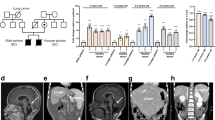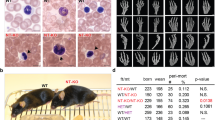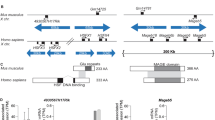Abstract
Dyskeratosis congenita (DC) is an inherited bone marrow failure syndrome associated with increased cancer susceptibility. The X-linked form is due to mutations in the DKC1 gene encoding dyskerin, a nucleolar protein predicted to be involved in rRNA processing and associated with the telomerase complex. Available evidence suggests the pathology of DC is due to telomerase defects. We have used the inducible Cre/loxP system to produce deletions in the murine Dkc1 gene in early embryogenesis. A large deletion lacking exons 12–15 and a small deletion lacking only the last exon, were produced. We found both deletions showed a parent-of-origin effect with 100% embryonic lethality when the mutation occurred on the maternal Dkc1. Embryonic analysis at day E7.5 and E9.5 showed no male embryos carrying either deletion whereas females with maternally derived deletions died around day E9.5, with degeneration of the extra embryonic tissue, in which the paternal X-chromosome is inactivated. Female mice carrying the deletion in the paternally derived Dkc1 show extreme skewing of X-inactivation with the wild type X-chromosome active in all cells. Since mice with no telomerase are viable in the first generations the lethality we observe is unlikely to be due to the effects of mutated dyskerin on telomerase activity.
This is a preview of subscription content, access via your institution
Access options
Subscribe to this journal
Receive 50 print issues and online access
$259.00 per year
only $5.18 per issue
Buy this article
- Purchase on Springer Link
- Instant access to full article PDF
Prices may be subject to local taxes which are calculated during checkout



Similar content being viewed by others
References
Alter BP, Young NS . 1998 Hematology of infancy and childhood Vol. 1: Nathan DG and Oski FA. (eds) Philadelphia: WB Sunders Company pp 216–316
Blasco MA, Lee HW, Hande MP, Samper E, Lansdorp PM, DePinho RA, Greider CW . 1997 Cell 91: 25–34
Cadwell C, Yoon HJ, Zebarjadian Y, Carbon J . 1997 Mol. Cell. Biol. 17: 6175–6183
Giordano E, Peluso I, Senger S, Furia M . 1999 J. Cell. Biol. 144: 1123–1233
Harper MI, Fosten M, Monk M . 1982 J. Embryol. Exp. Morphol. 67: 127–135
Heiss NS, Knight SW, Vulliamy TJ, Klauck SM, Wiemann S, Mason PJ, Poustka A, Dokal I . 1998 Nat. Genet. 19: 32–38
Hemann MT, Greider CW . 2000 Nucleic Acids Res. 28: 4474–4478
Keller P, Tremml G, Rosti V, Bessler M . 1999 Proc. Natl. Acad. Sci. 96: 7479–7483
Knight SW, Heiss NS, Vulliamy TJ, Aalfs CM, McMahon C, Richmond P, Jones A, Hennekam RC, Poustka A, Mason PJ, Dokal I . 1999a Br. J. Haematol. 107: 335–339
Knight SW, Heiss NS, Vulliamy TJ, Greschner S, Stavrides G, Pai GS, Lestringant G, Varma N, Mason PJ, Dokal I, Poustka A . 1999b Am. J. Hum. Genet. 65: 50–58
Knight SW, Vulliamy TJ, Morgan B, Devriendt K, Mason PJ, Dokal I . 2001 Hum. Genet. 108: 299–303
Lafontaine DL, Bousquet-Antonelli C, Henry Y, Caizergues-Ferrer M, Tolleryey D . 1998 Genes Dev. 12: 527–537
Lakso M, Pichel JG, Gorman JR, Sauer B, Okamoto Y, Lee E, Alt FW, Westphal H . 1996 Proc. Natl. Acad. Sci. USA 93: 5860–5865
Liu Y, Snow BE, Hande MP, Yeung D, Erdmann NJ, Wakeham A, Itie A, Siderovski DP, Lansdorp PM, Robinson MO, Harrington L . 2000 Curr. Biol. 10: 1459–1462
Mao X, Fujiwara Y, Orkin SH . 1999 Proc. Natl. Acad. Sci. USA 96: 5037–5042
Marciniak RA, Johnson FB, Guarente L . 2000 Trends Genet. 16: 193–195
McDevitt MA, Fujiwara Y, Shivdasani RA, Orkin SH . 1997 Proc. Natl. Acad. Sci. USA 94: 7976–7981
Mitchell JR, Cheng J, Collins K . 1999a Mol. Cell. Biol. 19: 567–576
Mitchell JR, Wood E, Collins K . 1999b Nature 402: 551–555
Prescott JC, Blackburn EH . 1999 Curr. Opin. Genet. Dev. 9: 368–373
Razin A . 1998 EMBO J. 17: 4905–4908
Spedaliere CJ, Hamilton CS, Mueller EG . 2000 Biochemistry 39: 9459–9465
Vulliamy T, Marrone A, Dokall I, Mason PJ . 2002 Lancet 359: 2168–2170
Vulliamy T, Marrone A, Goldman F, Dearlove A, Bessler M, Mason PJ, Dokal I . 2001a Nature 413: 432–435
Vulliamy TJ, Knight SW, Heiss NS, Smith OP, Poustka A, Dokal I, Mason PJ . 1999 Blood 94: 1254–1260
Vulliamy TJ, Knight SW, Mason PJ, Dokal I . 2001b Blood Cells Mol. Dis. 27: 353–357
Zebarjadian Y, King T, Fournier MJ, Clarke L, Carbon J . 1999 Mol. Cell. Biol. 19: 7461–7472
Acknowledgements
We thank SH Orkin, Howard Hughes Medical Institute, Harvard Medical School, Boston, MA, for the (GATA1-) cre+/− mice (without the chicken β-globin insulator sequences), EIIa-cre mice were generously provided by H Westphal, NIH, Bethesda, MD, USA. We thank Christian Mieschendahl for his contribution to the early stages of this project. We thank the Alvin J Siteman Cancer Center for the use of the Embryonic Stem Cell Core. This work was supported by National Institutes of Health grant RO1-CA-89091 and P30CA91842, the Barnes Jewish Hospital Foundation, American Cancer Society IRG-58-010-41 and by the Wellcome Trust.
Author information
Authors and Affiliations
Corresponding author
Rights and permissions
About this article
Cite this article
He, J., Navarrete, S., Jasinski, M. et al. Targeted disruption of Dkc1, the gene mutated in X-linked dyskeratosis congenita, causes embryonic lethality in mice. Oncogene 21, 7740–7744 (2002). https://doi.org/10.1038/sj.onc.1205969
Received:
Revised:
Accepted:
Published:
Issue Date:
DOI: https://doi.org/10.1038/sj.onc.1205969
Keywords
This article is cited by
-
The role of post-transcriptional modifications during development
Biologia Futura (2023)
-
The genetics of monogenic intestinal epithelial disorders
Human Genetics (2023)
-
New insights into the epitranscriptomic control of pluripotent stem cell fate
Experimental & Molecular Medicine (2022)
-
Generation of dyskeratosis congenita-like hematopoietic stem cells through the stable inhibition of DKC1
Stem Cell Research & Therapy (2021)
-
New prospects for targeting telomerase beyond the telomere
Nature Reviews Cancer (2016)



